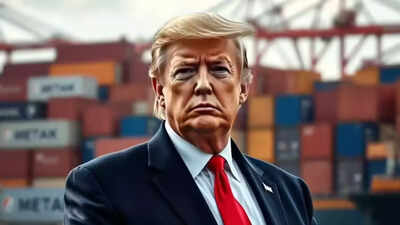Donald Trump tariff jitters: What’s latest on US trade war & what happens next? Check details

President Donald Trump has sharply expanded a barrage of tariffs since returning to office, aiming to overhaul global trade in favour of the United States. The sweeping measures, which target a broad range of foreign goods and industries, have triggered market fluctuations and strained ties with key American allies.Canada faces 35% tariffs; Brazil hit with 50% dutyIn his latest announcement, Trump said Canada would face a 35% tariff on many goods, citing the country’s alleged role in enabling fentanyl trafficking into the US. The move came just a day after he imposed a sweeping 50% tariff on all imports from Brazil.Trump claimed the Brazil tariff was partly a response to the ongoing trial of his political ally, former Brazilian President Jair Bolsonaro, who faces charges related to a failed coup attempt. Reacting strongly, Brazilian President Luiz Inácio Lula da Silva vowed retaliation, stating that Brazil “will not accept being abused by anyone.”50% tariff on imported copper Trump also plans to impose a 50% tariff on all copper imports starting August 1, citing national security concerns. The decision could raise costs for US industries reliant on the metal, especially manufacturing and construction.Tariff letters sent to more than 20 countriesTrump has escalated trade tensions by sending tariff letters to more than 20 countries, warning that higher import duties will take effect from August 1, 2025 if bilateral trade deals are not reached. The move marks a continuation of his aggressive “reciprocal tariff” policy first announced in April this year. The letters outline specific tariff rates, some adjusted from earlier levels.Many of the new tariff rates echo those Trump proposed in April, before temporarily suspending them, except for China, to give nations time to negotiate trade deals, according to The New York Times.Officials juggling negotiations with trading partnersSo far, two countries have managed to reach agreements with the US. A deal with the UK will lower tariffs on cars, steel, and aerospace parts. Another agreement with Vietnam sets a 20% tariff on general imports and a 40% duty on transshipped goods, lower than the initially planned 46%.Meanwhile, representatives from Japan, the EU, Malaysia, South Korea, Indonesia, and others have been meeting US officials to avoid the looming hikes.India is also stepping up talks. A commerce ministry team is expected to visit Washington next week for another round of discussions over the proposed bilateral trade agreement. While exact dates are yet to be confirmed, officials say the focus will be on finalising both interim and phase-one parts of the deal ahead of the tariff deadline, according to sources quoted by PTI.Who and what is facing tariffs?1. Steel and aluminum – 50% tariffIn June, the US doubled tariffs on foreign steel and aluminum to 50%. Trump said the move was aimed at countering countries that “undercut the competitiveness” of American industries.While intended to protect domestic producers, the higher tariffs are likely to increase costs for US companies that depend on these metals, such as automakers, construction firms, and oil drillers. Consumers may also see higher prices on goods like canned foods.2. Cars and auto parts – 25% tariffAll cars assembled outside the US and all imported auto parts now face a 25% duty. Trump claims the tariffs will boost investment and create jobs in the US, but analysts warn they could significantly raise new car prices and repair costs for consumers.3. De Minimis loophole closedIn May, Trump closed the “de minimis” rule, which had allowed retailers to ship goods from abroad—especially China—directly to US buyers without paying tariffs (for packages under $800).The rule helped e-commerce platforms like Shein and Temu flourish, but made it hard for US producers to compete. The closure is expected to slow down cheap imports but may also lead to higher prices for online shoppers.4. New tariff threats on a broad range of sectors, including:
- Semiconductors
- Pharmaceuticals
- Foreign-made movies (100% tariff proposed)
- iPhones manufactured outside the US (25% duty threatened)
5. Additional 10% tariff on BRICS nationHe has also issued a warning to the BRICS nations (Brazil, Russia, India, China, South Africa), threatening an additional 10% tariff on “any Country aligning themselves with the Anti-American policies of BRICS.”The European Union is also on Trump’s radar. He claimed the EU was “formed to screw the US” and threatened a 50% tariff if trade terms aren’t renegotiated.Why is Trump using tariffs?Trump believes the US trade deficit—when America imports more than it exports—is a sign of economic failure. He sees tariffs as a way to punish countries for “ripping off” the US and to bring back jobs and manufacturing.His administration claims that by making imports more expensive, companies will be forced to produce goods domestically, boosting employment and wages.But Trump also uses tariffs as leverage—to push countries into trade deals, extract concessions, or generate revenue that can be used for domestic programs like tax cuts.What do economists say?Experts argue that Trump’s tariff goals are conflicting. While he wants to boost US manufacturing, the higher costs of imported materials like steel and semiconductors can actually hurt American producers by raising their production costs and disrupting supply chains.Who really pays for tariffs and what happens next?A tariff is a tax that the government charges on goods brought in from other countries. In the US , these tariffs are paid by American importers—not foreign exporters—and the money collected goes directly to the US Treasury. For example, if Walmart imports shoes worth $100 from Myanmar, which now faces a 40% tariff, the company must pay $40 to the government, The New York Times reported.Walmart’s CEO recently warned that rising tariffs would likely lead to price hikes, prompting former President Trump to publicly urge the company to “eat the tariffs” and avoid raising prices.How companies are reacting to tariffs and what it means for consumer pricesThe ripple effects of tariffs are being felt across supply chains. With the US heavily reliant on Chinese factories for products like toys and Christmas decorations, many businesses have begun pausing holiday orders. Toymaker Mattel has already announced it will raise prices on US toys in response to tariffs on Chinese imports.While tariffs are known to drive up consumer prices, major inflation indicators like the Consumer Price Index have yet to reflect a sharp increase. Economists suggest it’s only a matter of time. Many companies stocked up on inventory ahead of tariff hikes, helping delay price increases, but as those supplies run out, consumers may soon see the difference at checkout.





